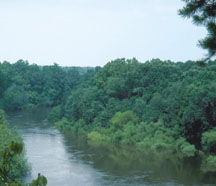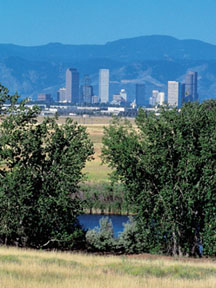Exchanges between groundwater and surface water vary among different landscapes. What governs these exchanges are soils, geology and hydrology.
Urban runoff
Groundwater and surface water exchanges are significant in carbonate aquifers
near San Antonio, Texas. Major streams lose substantial amounts of water
to the Edwards aquifer as they flow across the highly permeable, faulted
and fractured carbonate rocks of the aquifer outcrop. Fortunately, streams
that recharge the aquifer originate in, and flow through, what is now
mostly undeveloped rangeland. However, these streams also flow through
northern San Antonio, which is being developed. Some contaminants that
are typical of urban runoff are finding their way to the recharge zone.
For example, a 1996 to 1998 study of wells in the recharge zone detected
elevated concentrations of the herbicides atrazine, deethylatrazine, simazine
and prometon. Water quality in the Edwards aquifer and in the recharging
streams is a critical management issue for the region. The aquifer is
the principal water supply for the more than 1.5 million people in the
greater San Antonio region.
Finding the phosphorous
Groundwater and surface water interactions in the sand and gravel aquifers
of the Albemarle-Pamlico Drainage Basin in North Carolina help to explain
elevated phosphorus in selected streams. Deep groundwater underlying parts
of the Coastal Plain has relatively high concentrations of phosphorus
(a median concentration  of
0.25 milligrams per liter), which likely originates from phosphate minerals,
such as fluoroapatite, in the Cretaceous-age aquifer sands. Upward discharge
of the groundwater results in elevated levels of phosphorus in streams,
particularly in the Tar River and Neuse River drainage basins. Research
indicated a significant correlation for 25 sites sampled during August
and September 1995 between concentrations in discharging groundwater and
in streams. Documenting this natural source of phosphorus in the Albemarle-Pamlico
Drainage Basin has helped water-resource managers to better account for
phosphorus sources, and has helped in making more accurate Total Maximum
Daily Load estimates for some North Carolina streams.
of
0.25 milligrams per liter), which likely originates from phosphate minerals,
such as fluoroapatite, in the Cretaceous-age aquifer sands. Upward discharge
of the groundwater results in elevated levels of phosphorus in streams,
particularly in the Tar River and Neuse River drainage basins. Research
indicated a significant correlation for 25 sites sampled during August
and September 1995 between concentrations in discharging groundwater and
in streams. Documenting this natural source of phosphorus in the Albemarle-Pamlico
Drainage Basin has helped water-resource managers to better account for
phosphorus sources, and has helped in making more accurate Total Maximum
Daily Load estimates for some North Carolina streams.
The Neuse River at Cliffs of the Neuse State Park in North Carolina, during
high flow in 1996. Photo by Douglas A. Harned, USGS
Farms and groundwater
Significant exchanges of water and contaminants from the land surface
to the groundwater also can occur in permeable and well-drained alluvium
and sand and gravel. Along the Platte River in central Nebraska, the chemicals
farmers use for their crops can, during high streamflow, enter the adjoining
sand and gravel aquifers. The results are elevated levels of nutrients
and pesticides in the groundwater. A 1995 NAWQA study detected elevated
concentrations of the herbicide atrazine in observation and public-supply
wells in the Ashland well field, the source of almost all of the public-water
supply for the city of Lincoln. These elevated concentrations, reported
as high as 20 micrograms per liter, exceeded the Environmental Protection
Agency’s maximum contaminant level for atrazine of 3 micrograms per
liter. The atrazine was traced to the Platte River.

 In the South Platte
River Basin in Colorado, hundreds of water-withdrawal structures, dozens of reservoirs,
and several thousand pumping wells have significantly altered the natural hydrologic
system. These changes have affected the quantity and quality of water in the South
Platte River and nearby alluvial aquifer. Groundwater discharges to the South
Platte River during fall and winter. Seepage of irrigation water from agricultural
ditches and fields replenishes the alluvial aquifer during spring and summer.
But the irrigation water carries nitrate, dissolved solids and pesticides, such
as atrazine and prometon, from farms into groundwater. These substances are then
transported into the streams and river. Because water is withdrawn all along the
Platte River and then replaced by groundwater, the water is effectively recycled
or reused as it moves downstream. As a result, salinity has increased in a downstream
direction in the river and shallow alluvial groundwater. The salinity increases
are caused by evaporation, solution of soil minerals and concentration of salts
in the soil zone as plants use soil moisture. Elevated salinity makes the water
less suitable for irrigation and drinking.
In the South Platte
River Basin in Colorado, hundreds of water-withdrawal structures, dozens of reservoirs,
and several thousand pumping wells have significantly altered the natural hydrologic
system. These changes have affected the quantity and quality of water in the South
Platte River and nearby alluvial aquifer. Groundwater discharges to the South
Platte River during fall and winter. Seepage of irrigation water from agricultural
ditches and fields replenishes the alluvial aquifer during spring and summer.
But the irrigation water carries nitrate, dissolved solids and pesticides, such
as atrazine and prometon, from farms into groundwater. These substances are then
transported into the streams and river. Because water is withdrawn all along the
Platte River and then replaced by groundwater, the water is effectively recycled
or reused as it moves downstream. As a result, salinity has increased in a downstream
direction in the river and shallow alluvial groundwater. The salinity increases
are caused by evaporation, solution of soil minerals and concentration of salts
in the soil zone as plants use soil moisture. Elevated salinity makes the water
less suitable for irrigation and drinking.